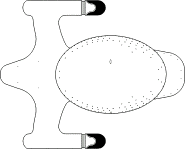



![]()
History
The USS CAPRICORN was built at Utopia Planitia Space Yards, above Mars. She was
commissioned on SD 11???? by Fleet Admiral Judi D'Arque after passing final
inspection from Branch Admiral Denton "Big Tex" Dupre, SF Engineering,
at Starbase Diamond. The CAPRICORN left Starbase Diamond under the command of
Captain Da'choH.
|
BASIC STATISTICS PHYSICAL SPECIFICATIONS COMPLEMENT PROPULSION SYSTEMS Impulse System Velocity ARMAMENT Photon Torpedo, MkXXIII
Seeking/Direct Deflector System: FD-10c Cocoon Multiphasic Deflector System OTHER SYSTEMS Turbolifts |
Notes: The DIOGENES-class is not primarily a fighting ship, but designed for long-range exploration making her one of the fastest ships in Starfleet. They are also highly maneuverable, having increased numbers of impulse "jets" positioned at several angles.
 |
 |
 |
|
Top |
Port |
Bow |
These ships are specifically designed for long ranged missions, often going years between resupply at a Starbase or planet, making the engineering challenges quite vast. But because of the hazardous nature of exploration, it carries a respectable array of defensive weaponry capable of repelling smaller threats and buying time for retreat from larger threats. Its defensive capabilities are supplemented by an advanced thrust vectoring system that makes it the most maneuverable cruiser in Starfleet. However, what it lacks in firepower, the ship makes up for in equipment for scientific exploration, research, and analysis. The ship's computer has been specifically integrated into laboratory systems to improve the rate of data processing of scientific data, making the DIOGENES-class vessel possibly the top science ship in the Federation.
While the internal volume of a DIOGENES-class starship is on similar order to that of the original GALAXY-class vessels, the two ships differ considerably in design, with that DIOGENSE-class being slightly smaller than their Galaxy Class counterparts.
The saucer section on the DIOGENES-class is more circular in planview and elliptical in cross-section than other saucer designs. The supporting pylon linking the primary and secondary hulls is connected at the front of the primary hull. The warp nacelles are positioned directly below and on either side of the secondary hull. Because of this unusual configuration, the DIOGENES-class cannot separate.
The supporting dorsal of a Diogenese Cruiser was connected at the front of the primary hull, rather than the rear, with the warp nacelles directly below and on either side of the secondary hull. This created a more vertical than horizontal configuration. Also, the primary hull was more of an ovoid, or "squashed globe" than a saucer.
